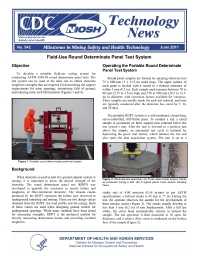Mining Publication: Technology News 542 - Field Use Round Determinate Panel Test System
Original creation date: June 2011
To develop a portable field-use testing system for conducting ASTM-1550-05 round determinate panel tests. The test system can be used at the mine site to obtain shotcrete toughness strengths that are required for determining the support requirements for mine openings, minimizing falls of ground, and reducing mine roof-fall incidents. Background: When shotcrete is used as part of a ground support system in mining, it is important to know the placed strength of the shotcrete. The round determinate panel test (RDPT) was developed to quantify the resistance to tensile failure and toughness of fiber-reinforced shotcrete. The tension cracks produced by the RDPT represent the failure type observed in underground tunneling and mining. There are two design values obtained from the RDPT, the load profile and the energy. Both of these values are used when designing ground control for underground openings. While many methods have been tested for measuring strengths, RDPT is the preferred method for directly measuring determinate breaks and providing resultant toughness. Operating the Portable Round Determinate Panel Test System: Round panel samples are formed by spraying shotcrete into 75 x 800-mm (3 x 31.5-in) mold rings. The upper surface of each panel is leveled with a screed to a flatness tolerance of within 5 mm (0.2 in). Each sample must measure between 70 to 90-mm (2 .75 to 3.5-in) high and 750 to 850-mm (29.5 to 33.5-in) in diameter, with correction factors available for variances. Three samples are usually made for each test interval, and tests are typically conducted after the shotcrete has cured for 7, 14, and 28 days. The portable RDPT system is a self-contained, closed-loop, servo-controlled, stiff-frame press. To conduct a test, a cured sample is positioned on three support pins centered below the test system's ram. After the ram is lowered to a position just above the sample, an automated test cycle is initiated by depressing the green start button, which initiates the test and also starts the data acquisition system. The ram is set at a stroke rate of 4.00 mm/min (0.16 in/min) as per ASTM specifications; a full test stroke is 45 mm (1.77 in). During the test, the operator observes the sample for the development of three tension cracks. The cracks usually develop at less than 5 mm (0.2 in) of ram displacement. After a full test stroke, the press head automatically retracts to unload the sample. The test specimen is then measured in 10 spots for thickness, and a relative fiber count is conducted on the broken face of the sample. Data for load and displacement is gathered using an Eaton data logger.
Authors: LA Martin, CC Clark, JB Seymour
Technology News - June 2011
NIOSHTIC2 Number: 20039247
Pittsburgh, PA: U. S. Department of Health and Human Services, Public Health Service, Centers for Disease Control and Prevention, National Institute for Occupational Safety and Health, DHHS (NIOSH) Publication No. 2011-187, TN 542, 2011 Jun; :1-2
See Also
- Developments in Sealant Support Systems for Ground Control
- The Long-term Performance of Surface Support Liners for Ground Control in an Underground Limestone Mine
- Roof and Rib Hazard Assessment for Underground Stone Mines
- Roof Screening for Underground Coal Mines: Recent Developments
- A Shotcrete Adhesion Test System for Mining Applications
- Shotcrete Design and Installation Compliance Testing: Early Strength, Load Capacity,Toughness, Adhesion Strength, and Applied Quality
- Technology News 434 - An 'Insulating' Shotcrete for Heat Abatement in Deep Mines
- Technology News 526 - Proceedings of the International Workshop on Rock Mass Classification in Underground Mining
- Technology News 540 - Field-Expedient Shotcrete Adhesion Test System
- Variation of Horizontal Stresses and Strains in Mines in Bedded Deposits in the Eastern and Midwestern United States
- Content source: National Institute for Occupational Safety and Health, Mining Program


 ShareCompartir
ShareCompartir
